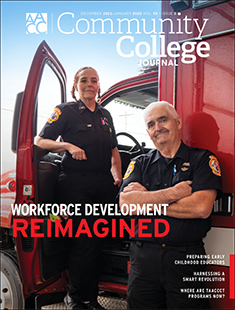In Ohio, a group of community colleges has reduced the time it takes for students to earn a credential by awarding credit based on competency rather than seat time.
In Mississippi, high school dropouts and other low-skill adults are receiving critical workforce training and even earning a college degree, thanks to a program that has transformed the delivery of remedial education.
This excerpt comes from an article in the current issue of the Community College Journal, published by the American Association of Community Colleges.
And in California, an innovative public-private partnership has revolutionized the way students are prepared for manufacturing jobs and other in-demand careers by modeling instruction after a 40-hour workweek.
All these efforts are a result of the federal Trade Adjustment Assistance Community College and Career Training (TAACCCT) grant program, which provided nearly $2 billion over four years to help community colleges meet employers’ needs more effectively in response to the 2008 recession.
As the pandemic continues to disrupt industries and create a demand for professional reskilling, Congress has considered reviving the TAACCCT program to address a new set of challenges.
Distributed by the U.S. Department of Labor, the original TAACCCT funding brought colleges and businesses together to solve key workforce needs. The program resulted in large-scale, systemic reforms whose impact continues to be felt today.
Grant recipients agree the changes they made would not have been possible without the TAACCCT support they received. As colleges and industries grapple with the effects of the pandemic, many institutions believe a renewed TAACCCT program makes sense.
“The world of work has been so disrupted because of Covid,” says Matthew Sweeney, director of workforce innovation and strategy for the Community College of Denver (CCD). “Reauthorizing TAACCCT would allow colleges to rethink their existing models of instruction to retrain workers and meet the changing needs of employers more rapidly.”
Accelerated learning
Mississippi businesses often struggle to hire skilled workers because of the many adults in the state without a high school diploma. Before, these individuals had to earn a high school equivalency prior to enrolling at a community college, which proved to be a barrier in advancing their education. Because of TAACCCT, however, Mississippi residents now can acquire the skills they need for employment while working on their high school equivalency simultaneously, thus hastening their time to completion.
The Mississippi Community College Board (MCCB) partnered with the Louisiana Community & Technical College System on a TAACCCT-funded project to retrain Gulf Coast adults for information technology (IT) jobs. As a result of the project, five Mississippi colleges adopted innovations based on the I-BEST model developed in Washington state.
One of these innovations was a team-teaching approach that pairs career and technical education and adult education instructors in the same classroom. This approach allows high school dropouts to complete their high school equivalency while concurrently earning a postsecondary degree or certificate.
The participating colleges also hired college and career navigators to help students complete the admissions process and support them in other ways.
“A community college student is often just a flat tire away from dropping out,” says Kell Smith, MCCB’s director of communications and legislative services. “We were able to provide some of those wraparound services that are so important for success.”
With support from the W.K. Kellogg Foundation, Mississippi has expanded this “MIBEST” program to all 15 community colleges in the state. The program had enrolled nearly 2,000 students statewide, more than half of whom are 25 or older — and 55% of whom have earned their high school equivalency through MIBEST.
“Colleges should be excited” about the reauthorization of TAACCCT, Smith says, because it “opens the door for more students to enter community colleges and the workforce.”
Preparing the unprepared
Arkansas’ 22 community colleges shared a $15 million TAACCCT grant to implement numerous evidence-based completion strategies. As in Mississippi, a key component of these reforms was redesigning developmental education to reduce the time to completion.
The goal of the Pathways to Accelerated Completion and Employment (PACE) initiative was to prepare students for high-demand careers more quickly, says Mike Leach, director of the Arkansas Community Colleges’ Center for Student Success — especially students who were underprepared.
Each college chose a handful of career pathways that were experiencing the largest demand in which to implement the reforms, which borrowed strategies from Complete College America. These included co-requisite support, in which underprepared students can enroll in gateway math and English classes and receive just-in-time support — allowing them to complete the courses without having to take remedial classes first. Other reform strategies included reductions in program credit hours, virtual career centers, and hybrid instruction to reduce seat time and better accommodate working students’ schedules.
Most of these TAACCCT-funded reforms still exist today. For instance, “we’re approaching 75% of underprepared students enrolled in co-req courses across the state,” Leach says.


